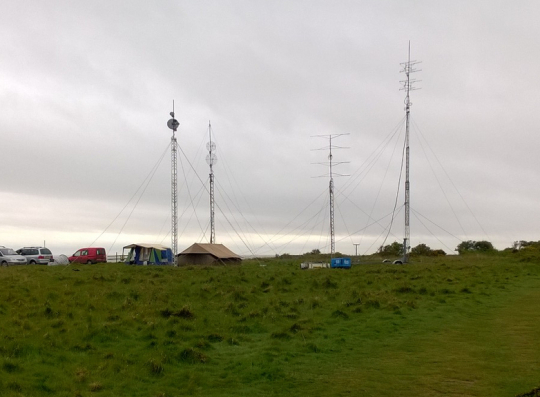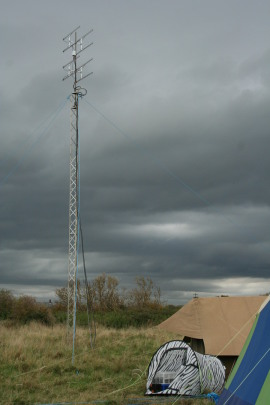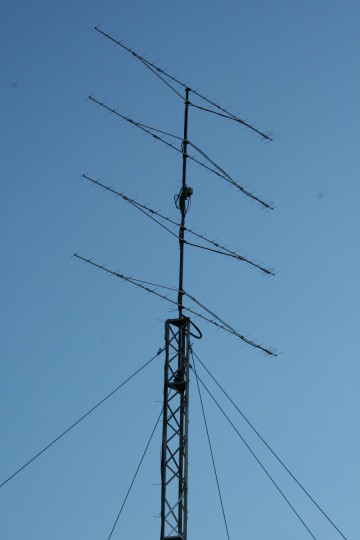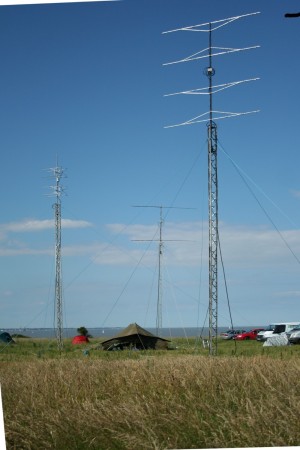
RECENT UPDATES
Weather November 2023
Watts up ? November 2023
Blog 13 June
Contesting 22 May
For Sale 20 May
EME listing 22 March
70cms updated Feb '15
Kits Jan 2015
Yagis and SWR Jan 2015
Contesting with the Colchester CG
May UHF and microwave contest 2015
may 144mhz contest 2015
UHF and Microwave contest october 2014
Our 2m outing to the seaside in September was beset by a number of problems and we took a series of measures to ensure that the Gremlins did not visit again. We largely succeeded and in summary the contest weekend was agreed to be good. But I’m getting ahead of myself.
In the run-up to the contest, replacement 23cm Tonnas were purchased and assembled, and the 23cms preamp was rebuilt to include a bandpass filter. There was an awkward moment when I loaded the car and spotted that the current 23cms Tonna is a slightly different design to the older ones and would not therefore fit the stacking frame without modification. It could have been worse, if this had come to light on site.
On Friday afternoon we gathered on site and assembled 3 lattice masts, and populated them with the 23cms and 70cms arrays – 8 x 23ele and 4 x 21ele respectively. Two tents were put up – one for operating and one for catering. Then it got dark; that’s the problem with October, there’s almost as much dark as light.
On Saturday morning, Robin returned to site with all the gear for 6cms, 3cms and 24GHz. Much of this, including the transverters is fitted to the top of the mast, with DC and control cables running to the shack together with 144MHz IF cables. In the past we’ve included a 2m yagi for microwave talkback, but with growing use of, and dependence on ON4KST Chat, this is the first occasion without it. Here’s G8APZ wiring up the microwave masthead.
By mid morning the 23cms tower was vertical and the wind was starting to get up. We knew from the weather forecast that it would be a close run thing – whether the front reached us just before or just after the contest start. As it happened the rain began about 30mins before the contest and this photo is of the 23cms array at that time.
By then Phil had completed testing the 23cms station and pronounced himself satisfied. Plenty of power from the DB6NT amplifier, and no problems from receive intermodulation (which had decimated our VHF NFD operations). So Phil was very relaxed, and was storing up some energy for all those QSO’s to follow.
Last mast up in the air was for 9cms, just as the rain set in. Here’s Phil, Mike and Joe checking it over before erection.
It wasn’t our imagination, it really was a cold front coming in !
As the rain set in and the wind strengthened further, we got stuck in to the contest. 70cms, despite the weather was working well into Germany and it was quite early on that the first OK was worked on the band. From time to time we struggled with static from the rain. As many contacts as possible were “passed up” to 23cms, mindful of the Trophy Contest taking place on 23 and 13cms for the first few hours. Perhaps one in four stations were able oblige with and attempt at the higher band and the majority of these attempts resulted in a contact.
On the other side of the tent, Robin and Joe were studiously using ‘KST to arrange skeds on the higher bands, with 3cms (10GHz) being by far the most popular. Traffic on KST moves at a fast pace during a major contest and we noticed that a number of our requests for skeds were being missed. Even so, several German stations appeared in the log during the evening, along with PA0, ON and F. There were even a few G stations.
We look forward to showers to provide rain scatter contacts on 3cms. Unfortunately, sitting inside a three hour long drenching did nothing at all for our propagation.
Just before it got dark, the sun came out for half an hour or so. Mike was looking forward to it warming up again – what an optimist.
Inevitably, Sunday was a quieter day for making contacts; we had worked most of the easy ones. Even so, 70cms continued to provide some good ones, probably by aircraft scatter but we were not equipped to analyse this. By the end of the contest we had just short of 180 contacts on 70cms.
On 23cms there was a short interlude while the mast was taken down to investigate a high SWR. This was isolated to a short length of Ecoflex 15 round the rotator and on inspection dampness was noted inside the N type connector. We can only assume that during Saturdays deluge some water got in, although it’s curious that it took so long to take effect. Thankfully the protection circuitry on the DB6NT amplifier worked well.
23cms contacts totalled 81, with the best distance being into Czechoslovakia. This is a great improvement on recent previous contests and we feel that 23cms is now really back on form.
This year we were unable to field any 13cms equipment. Well, we have to leave something for next time.
9cms proved problematic and perversely it worked best just near the end of the weekend. Best DX was into IO81 square.
12 contacts were made on 6cms with DF0MU being the best.
21 contacts were made on 3cms with DJ5BV being the best at 423km. Five German stations found their way into the log.
3 contacts were made on 24GHz with no QSO’s outside JO01/02 squares. This contrasts with previous recent contests where we have made a habit of getting at least one contact across the North Sea. It wasn’t for lack of trying though.
Takedown continued well into the dusk, but without mishap. To incorrectly quote an old sitcom – “you’ve all done ferry well !”
144 MHz trophy contest 2014
This one will go down in our records as the most accident prone contest for many years. A Gremlin paid us a visit, decided to stay for the weekend and invited his extended family along for the ride.
Not only did we have technical difficulties, but the weather was also completely uninspiring. For the entire weekend it was misty and damp, but at least it was calm. A slight breeze from time to time came from the north-west, passing over the local sewage treatment works on its way. The mist and dampness was relieved a little on Saturday night by the formation of fog, and by a sharp shower just before the contest closed on Sunday. One benefit of the mist was that Felixstowe disappeared – this is the best thing that has happened to it for years.
Setup began on Friday afternoon. Our cunning plan was to erect the primary 2m array before dark, together with the tent and with cables and generator set up. It became evident that not quite all the primary aerial parts had arrived: the all important mounting clamps had been left behind. We also realised that we only had the bare minimum of guy ropes on site, whereas we had intended to put extra guys for safety on the 50ft tower. Gremlins 1: Contest Group 0.
Undaunted, we moved on to Plan B and assembled the tower for a secondary array. Our plans for the weekend included some testing of 23cms equipment, using the secondary mast prior to the contest, so the 23cms aerials were put together ready for the morning. Then it got dark.
On Saturday morning the 23cms aerials and their mast were completed and raised. It needs to be understood that raising our masts is done with a falling derek and tow car. Whilst driving through the long grass from mast to mast, the tow car drove over a guy stake. It made an interesting noise – so did the driver. In mitigation, it must be said that it was at least 30 minutes since the same person had bashed these into the ground with a sledgehammer. Perhaps one of the Gremlin family had moved it.
It can be reported that the 23cms tests went well, and proved that the specially constructed bandpass filter was working well. Then it was time to lower the 23cms aerials and put the 2m secondary array on that mast for the contest. There was a misunderstanding about which ropes were and were not attached at the time of lowering the mast, and the mast returned to the horizontal position without any restraint at all. All the 23cms aerials were written off. The Alimast survived with just a minor dent where it hit a support trestle. We did have an operator standing by to catch and guide the mast as it was lowered. He’s a relatively new addition to the team and as the mast hurtled to the ground as fast as gravity could manage, he ran away. He won’t be invited again.
Whilst again driving from mast to mast, the driver of the tow car drove over both the 2m aerials for the secondary array. These had been carefully concealed in the long grass by a Lesser Spotted Gremlin. After a bit of pulling and straightening, these were deemed useable, for this occasion at least.
Attention reverted to the primary array for the contest, now that all the parts were on site. These were cabled up and a masthead preamp added, and the mast was raised without mishap. Back in the tent we did a bit of tidying up. In the process of doing this it became evident that a 2m masthead preamp was in the tent, which was most odd because one was scheduled to be on each 2m array. Then the penny dropped – by accident a 23cms preamp (part of the earlier tests) had been included on the 2m array. In mitigation, the boxes are identical, with only a discreet marker to indicate the band in use. We can assume that Mrs Gremlin was involved in the design.
So the 2m primary array had to be lowered again to swap preamps. Whilst driving through the long grass from mast to mast, the tow car drove over a guy stake. You might be surprised to read this again, but it is not a typo nor is it an errant cut and paste.
Despite the efforts of the Gremlin family, we were ready for the contest just in time. There was a momentary hiccough during testing when the generator circuit breaker tripped and this was put down to a seldom used mains filter in the tent. It’s headed for the scrap bin. There was another hiccough when burning was smelt while waiting for the amplifier to warm up. This turned out to be a power supply fan that wasn’t, erm, turning.
It would be nice to report that the contest itself went without incident, and actually that is largely true. However, around midnight one of our operators left to drive home and you might think that there would be an incident with a guy stake. No, he’s not so daft. Instead, it was found that the Council security man had locked the site gate with a new padlock, to which we did not have a key. This is particularly frustrating as I had contacted the Council a week earlier and specifically asked about keys and locks. Whilst turning round at the locked gate, the driver had an incident with one of the timber bollards that guide drivers along the car park track. In mitigation, it must be pointed out that the posts are only about 500mm high, there is no lighting, and it was foggy.
In the contest we made around 420 contacts, with a best DX of some 900km. This is a pleasing improvement on 2012, and on 2013 when we were unable to make an entry from our seaside location.
Not surprisingly, we were very careful when taking all the equipment down at the end of the contest, and there were no mishaps. Mind you there was just one last instance …… whilst driving through the long grass from mast to mast, the tow car drove over a guy stake.
MAY 2013 UHF CONTEST
Colchester Contest Group – Winners !
Very good news; CCG are overall winners of
the contest. We got top spot on 23, 9, 6 and 3cms and 24GHz. We were also
winners of the concurrent 10GHz Trophy contest, and placed 2nd in
the 70cms Trophy contest. An excellent result for our small team.
M1CRO/P (Colchester Contest Group) was active during the May 2013 UHF contest
from JO01. We fielded equipment for 70cms, 23cms, 9, 6 and 3cms and 24GHz. Not
quite a full house, but plenty to keep the operators busy.
On 70cms there were in effect two contests,
being the 24 hour RSGB and IARU plus the RSGB Trophy for the first 8 hours. We
had over 170 QSOs, with best DX well into Germany at 780km. The equipment was
400w to 4 x 21 ele F9FT. About an hour was lost during Saturday evening while
we sat under some heavy static rain showers. A quick look at live rainfall maps
on the internet showed that nowhere else in the UK had any rain at all, only along
the Tendring coast.
Close to 50 QSO’s were made on 23cms, using
about 100w to a dish. This made for an interesting comparison with the regular
4 x 23 or 8 x 23 ele yagis that we have
used in the past. Best DX was DL0GTH at 674km.
The equipment for 9cms was relatively
untried, so it’s good to report success with 12 QSO’s including contacts into
GD (best DX 470km) and DL.
For 6cms, 3cms and 24GHz the equipment
line-up was provided by G8APZ, all tried and tested gear, however we seemed to
be down on receive performance on 6cms, so apologies to those who we could not
quite hear. Even so, 8 QSO’s were made. 26 contacts were made on 10GHz,
including PA0 and DL (best DX 412km), but we missed GD, believed to be due to equipment
problems at their end. 24GHz provided us with 4 QSO’s, including the now
regular contact with PA6NL at close to 200km.
I’m writing this on “the morning after”.
The car is yet to be unpacked, and the trailer likewise. We used two MPV’s, one
van, two cars and 3 trailers to get the gear to site and back again. This
contest is the most “equipment hungry” one of the year, with the possible
exception of VHF NFD. As for “wireless”, well you should have seen the amount
of “wire” strewn around the tent and the field !
The photos show: G8APZ with 6cm, 3cm and
24GHz, G1OGY and G0JJG with 70cm and 9cm, dishes for 23cms and 9cms, yagis for
70cms, dishes for 6cm, 3cm 24GHz and 2m talkback.
Best 73 and thanks for the QSOs de G1OGY,
G8APZ, G0JJG, G0JBA, G0IBZ and G4ZTR.















































